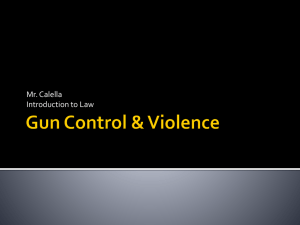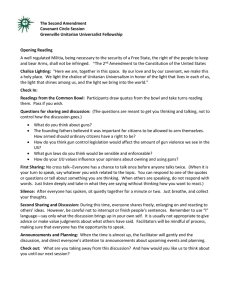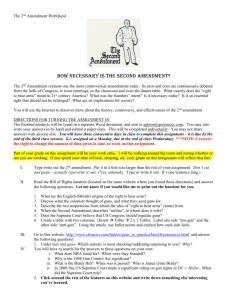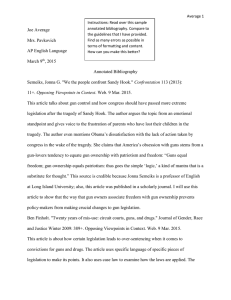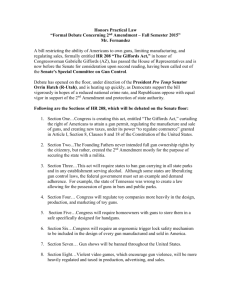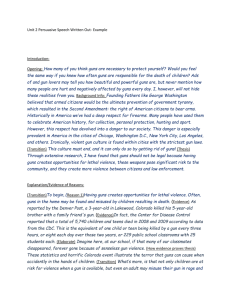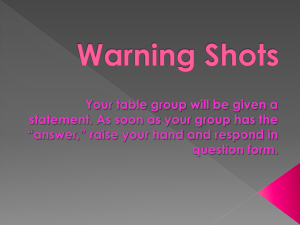Thesis
advertisement
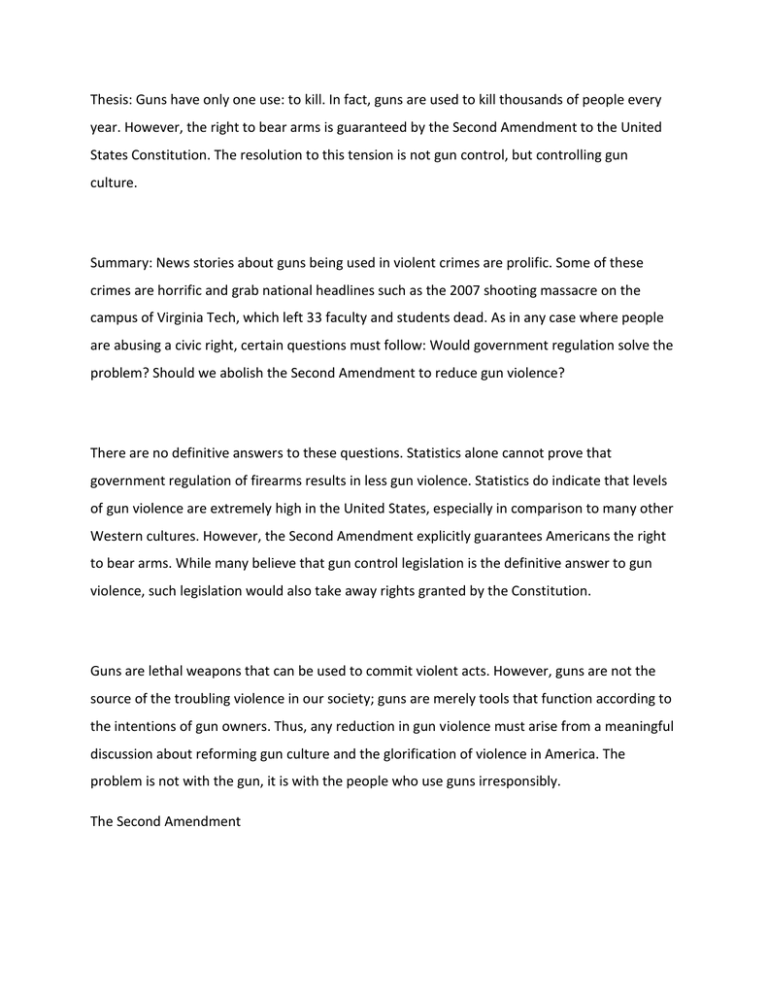
Thesis: Guns have only one use: to kill. In fact, guns are used to kill thousands of people every year. However, the right to bear arms is guaranteed by the Second Amendment to the United States Constitution. The resolution to this tension is not gun control, but controlling gun culture. Summary: News stories about guns being used in violent crimes are prolific. Some of these crimes are horrific and grab national headlines such as the 2007 shooting massacre on the campus of Virginia Tech, which left 33 faculty and students dead. As in any case where people are abusing a civic right, certain questions must follow: Would government regulation solve the problem? Should we abolish the Second Amendment to reduce gun violence? There are no definitive answers to these questions. Statistics alone cannot prove that government regulation of firearms results in less gun violence. Statistics do indicate that levels of gun violence are extremely high in the United States, especially in comparison to many other Western cultures. However, the Second Amendment explicitly guarantees Americans the right to bear arms. While many believe that gun control legislation is the definitive answer to gun violence, such legislation would also take away rights granted by the Constitution. Guns are lethal weapons that can be used to commit violent acts. However, guns are not the source of the troubling violence in our society; guns are merely tools that function according to the intentions of gun owners. Thus, any reduction in gun violence must arise from a meaningful discussion about reforming gun culture and the glorification of violence in America. The problem is not with the gun, it is with the people who use guns irresponsibly. The Second Amendment The Second Amendment to the US Constitution states: "A well regulated militia being necessary to the security of a free State, the right of the People to keep and bear arms shall not be infringed." On the surface, the amendment is straightforward. Militias are volunteer groups of citizensoldiers. Article I, Section 8, Clauses 15 and 16 of the Constitution give Congress the right to assemble the militia when the country is under attack or threatened with insurrection. The corresponding right to keep and own guns ensures citizens are not only armed to protect themselves in the event that national security is threatened, but the right to bear arms also prohibits the government from suppressing its own citizens by prohibiting personal possession of weapons and then demanding cooperation through force or threats of violence. Thus, the Second Amendment was enacted primarily in a military context. It grants people the right to keep and bear arms and then also stipulates the reason for their use. As is often forgotten, the drafting of the US Constitution represented a compromise between a clash of opposing interests. It was drafted six years after the War of Independence (a war in which a majority of troops were members of volunteer militias, using their own personal firearms). In the original version of the Constitution, published September 17, 1787, the first seven articles of the document merely established the branches of government-legislative, executive and judicial-and specified the powers granted to each one. However, there was considerable political opposition to this first draft. Opponents charged that the Constitution as written would merely centralize a tyrannical federal government, exactly the same type of government the American people had rebelled against. In order to placate the opposition, James Madison drew up the Bill of Rights, consisting of amendments that would (theoretically) defend the people from government tyranny. Therefore, the Bill of Rights guarantees individual rights, and also protects citizens from an intrusive government. The Second Amendment is elegantly designed to balance the right of the people to resist tyrannical government with the power of Congress to raise and deploy the militia when necessary. It is important to note that while the Second Amendment grants people the right to bear arms, it does not provide any guidance about how the people should use their arms when they are not serving in the militia. It does not mention owning a gun for sport or for hunting. Nor does it mention owning a gun for self-defense. It is also silent on the issue of the use of weapons in the commission of crimes. In sum, the Second Amendment does not endorse or proscribe gun use; it only grants people the right to own guns in order to have an effective militia. The Death of the Second Amendment, 2007 In 1787, when the Constitution was originally adopted, the standard firearm was the handmade flintlock rifle. Both cumbersome and inaccurate, a trained rifleman was lucky if he could fire more than two shots a minute with a flintlock. Since the Industrial Revolution was only just beginning, this was the only firearm the Founding Fathers knew. More than two hundred years later, in the twenty-first century, there are many more guns in the hands of Americans and today, these guns are cheap to manufacture, easy to use, highly accurate and incredibly lethal. Gun violence is a daily occurrence throughout the United States. Horrific events like the Columbine High School shootings in 1999 or the more recent Virginia Tech massacre have caused many Americans to call for new gun control legislation. What influence should the Second Amendment have in modern America? Unfortunately, the original purpose of the Second Amendment was overridden over a hundred years ago when the federal government assumed control over state militias by establishing the National Guard at the beginning of the twentieth century. All firearms used by the National Guard are now provided by the Department of Defense, which explicitly prohibits Guard members from keeping these guns in their homes. By removing this crucial link between individual gun ownership and service in the militia, the federal government essentially nullified the intent of the Second Amendment as envisioned by the Founding Fathers. Despite the best efforts of gun lobbyists, gun control laws have a long history in the United States. Throughout the nineteenth and twentieth centuries, local, state and federal government have enacted thousands of laws regulating the sale, purchase and use of firearms. Even today, there are gun control laws on the books in every state that vary from the highly restrictive to the highly permissive. For example, in both Vermont and Alaska (states with low population densities), citizens can carry a concealed weapon without any sort of government-issued permit. In Washington, DC, a city suffering from some of the highest murder rates in the country, residents are banned from even owning a handgun. However, at the federal level, several laws regulate the sale and use of guns. The Firearm Owners Protection Act of 1986 provides broad regulations of the firearm industry, including the prohibition of the sale of guns to specified persons such as minors, drug users, or those with a criminal record or a history of mental disorders. Other federal laws also regulate the sale and possession of firearms. The Brady Handgun Violence Prevention Act requires the criminal history of gun purchasers to be checked at the point of sale. A federal ban on assault weapons expired in September 2004 and there are now numerous efforts to have the ban reenacted. Although the US Supreme Court has consistently upheld the right to bear arms under the Second Amendment, it has largely relegated gun regulation to individual states. Thus, the historical setting that led to the adoption of the Second Amendment has changed significantly over time. Today, private citizens no longer serve in state-sponsored militias nor furnish their own weapons for any type of military service. Thus, the original intent of the Second Amendment has been heavily regulated by local, state and federal legislation. However, the Second Amendment remains part of the Bill of Rights. Any American citizen (or private organization) can challenge the constitutionality of gun control laws. Because of the significant costs involved in taking a case to trial in our legal system, the gun control debate has become highly lucrative for lawyers and lobbyists arguing for or against gun control. Moreover, gun manufacturers make huge profits from the sale of guns, and in turn help fund organizations like the National Rifle Association (NRA). Does a gun company like Smith and Wesson truly believe in protecting the civil rights guaranteed by the Second Amendment or is it more concerned that gun control legislation might affect its profits? The Gun Culture Guns are designed to kill. They have no other function. Throughout the United States, thousands of hunters legally use guns to kill animals. Likewise, throughout the United States, people use guns every day to kill other people. If a person can prove self-defense as a motive for killing another person, murder charges will generally not be brought against the killer. Yet, these uses of guns were not the primary motivations for the passage of the Second Amendment. In the late eighteenth century, both common law and common sense recognized that people had the right to use guns to hunt for food in the American wilderness, as they had the right to use guns to defend themselves if attacked. These rights were so basic that they were not enumerated in the Second Amendment. However, starting with nineteenth-century dime novels about the Wild West and continuing to the Hollywood action films of today, the gun culture has been influential in American society. Films that glorify gun use have often done very well at the box office. Some of Hollywood's favorite action figures, such as John Wayne, Clint Eastwood, Sylvester Stallone, Bruce Willis and others, used guns to save the day. Modern genres of music also celebrate guns in lyrics and videos. Meanwhile, gun manufacturers continue to profit from the sale and distribution of guns, as do lawyers and lobbyists representing the firearm industry. Politicians of all stripes take campaign money from advocates representing interests both for and against gun control. Thus, a great deal of money is at stake in both gun culture and its interest groups. However, gun control is the wrong debate. There are thousands of people in the United States who own firearms and use them responsibly and legally. There are plenty of people who do not. Gun culture is influenced by both the legal and illegal use of firearms. The framers of the United States Constitution granted Americans the right to bear arms. With this right comes the responsibility to exercise it wisely. Instead of trying to control guns, perhaps the time has come for Americans to take a hard look at why so many of our citizens feel the need to use guns irresponsibly.
